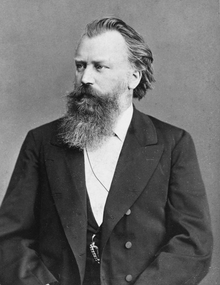Cello Sonata No. 2 (Brahms)
From Wikipedia, the free encyclopedia
The Cello Sonata No. 2 in F major, Op. 99, was written by Johannes Brahms in 1886,[1] more than twenty years after completing his Sonata No. 1. It was first published in 1887.[2] It was written for, dedicated to and first performed by Robert Hausmann, who had popularised the First Sonata, and who would the following year be given the honour of premiering the Double Concerto in A minor with Joseph Joachim.
| Cello Sonata in F major | |
|---|---|
| No. 2 | |
| by Johannes Brahms | |
 The composer c. 1885 | |
| Native name | Sonate für Klavier und Violoncello |
| Key | F major |
| Opus | 99 |
| Composed | 1886 |
| Dedication | Robert Hausmann |
| Published | 1887 |
| Movements | four |
Musical description
There are four movements:
First movement
The Allegro vivace is a sonata form opening with a fragmented cello theme over a tremolo piano part.[3] Its bipartite exposition somewhat unusually traverses F major, C major, and A minor;[4] Roger Graybill argued that the tonal plan may be read as ultimately returning to F major, given the intricate motivic structure of its voice leading.[5]
Second movement
Adagio affettuoso, with the cello part opening in a pizzicato exposition of the main theme over piano chords.[6] The central section is in F minor.[7]
Third movement
Allegro passionato in F minor, with a more songlike trio section in F major.
Fourth movement
Allegro molto; a rondo.
Notes
External links
Wikiwand - on
Seamless Wikipedia browsing. On steroids.
